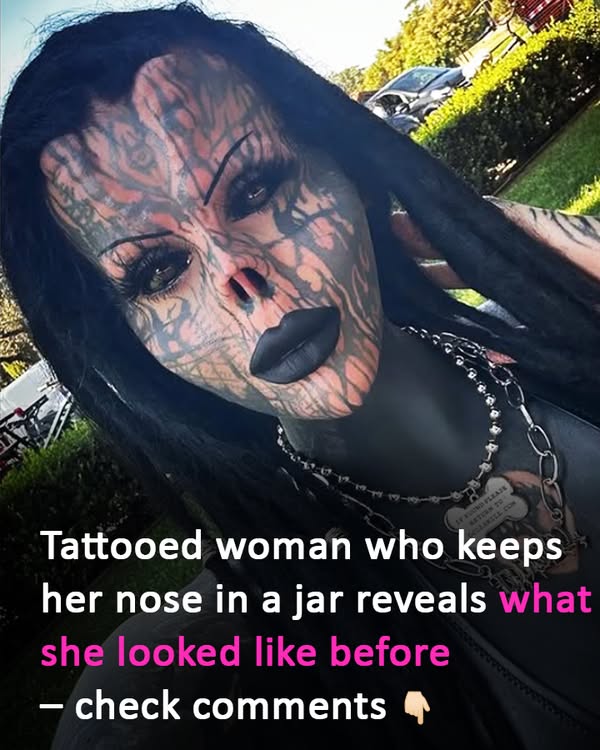In the digital age, recovery doesn’t always follow a conventional path. For some, it’s physical healing. For others, it’s emotional, mental, or even spiritual restoration. But for Toxii, a woman who has captivated and polarized social media, recovery has taken a radically visual form — through full-body transformation and extreme self-expression.
Her journey may not look like the typical path to peace, but for Toxii, her tattoos, implants, and modifications are more than aesthetic statements — they’re markers of ownership over her body and her past. As she puts it, “Imperfections make you unique.”
From Conventional Beauty to Unapologetic Individuality
Just a few years ago, Toxii had long blonde hair, a soft glam style, and not a single tattoo. In 2019, she fit neatly into society’s standards of beauty. Fast forward to today, and she’s nearly unrecognizable: jet-black hair, blacked-out tattoos across her upper body, eye tattoos, a split tongue, and even horn-like implants in her forehead.
She has even removed parts of her body — including her nose — and kept them preserved in small jars as mementos of her transformation.
What may shock many is that this extreme change wasn’t about rebelling or chasing attention. For Toxii, it was a personal recovery — a release from past pain and the beginning of self-acceptance.
.
Pain, Process, and Purpose
When asked in a recent interview by artist Devon Rodriguez which part of her transformation hurt the most, Toxii didn’t hesitate:
“My nose removal was way worse than the implants.”
The healing process took eight weeks, but she says the emotional reward outweighed the physical pain. That kind of endurance — physical and psychological — mirrors the same resilience seen in those overcoming trauma or going through rehab.
Just as some people seek treatment for emotional wounds through therapy or healing retreats, Toxii’s chosen therapy involved reclaiming control over her appearance. Her transformation might not be traditional, but the intention behind it is deeply human.
📖 Full Story: Pope Francis Describes Death as a New Beginning Before His Passing
The Internet Reacts: Criticism, Curiosity, and Concern
With over 160,000 followers on Instagram, Toxii has no shortage of attention — or controversy. Her transformation has triggered a wave of comments, ranging from admiration to outright attacks.
- “You were so beautiful before,” one person wrote.
- “Why do you hate yourself?” asked another.
- Others speculated dark, even paranormal influences: “She’s possessed by a poltergeist.”
These reactions raise important questions about how society responds to people who defy norms. Is Toxii’s transformation any different from those who choose to alter their lives with expensive cosmetic surgery, mortgage-funded procedures, or private insurance-backed enhancements?
”
One difference, perhaps, is transparency. Toxii documents everything — from the surgeries to the scars — sharing her recovery openly and honestly.
Transformation as Empowerment
Despite the criticism, Toxii remains unapologetically herself. She poses confidently, explains her choices with clarity, and embraces every step of her journey. For her, body modification isn’t about shock — it’s about survival, autonomy, and artistic freedom.
”
Her story echoes many themes seen in legal and ethical discussions around body autonomy. Lawyers and attorneys who specialize in personal rights have long debated the limits of self-expression, especially when it challenges societal norms.
But one thing is certain: the freedom to modify one’s body — whether through tattooing, surgery, or lifestyle — is rooted in deeply personal motivations.
💡 Also Read: 12 Health Benefits of Ginger – From Nausea Relief to Reducing Inflammation
Identity in a Post-Digital World
We live in an age where everyone is building a brand — sometimes consciously, other times unconsciously. People invest in their homes, their credit, their careers, and their social presence. For some, self-worth is measured in likes, follows, or even their ability to transfer wealth and influence across platforms.
Toxii’s transformation cuts through that noise. She’s not selling products. She’s not chasing a corporate endorsement. She’s simply existing as herself — and that has become both her message and her power.
As she once stated:
“I like to be imperfect, and I think that imperfections make you unique.”
This mindset reflects the broader evolution of how people pursue recovery today. Whether it’s a college degree, financial loans for a fresh start, or body transformation, we all seek control in different ways.
Body Autonomy and Future Trends
Toxii is not the first — nor will she be the last — to use body modification as a tool for empowerment. As technology advances and access to procedures increases, we’re likely to see more people redefining themselves in bold and unconventional ways.
This opens the door to new debates:
- Should there be age limits for extreme procedures?
- How should insurance handle claims involving elective body modification?
- When does expression become exploitation?
These are questions that future conferences, medical ethics panels, and even courts may have to address. For now, individuals like Toxii are forging their own paths — and daring society to look beyond the surface.
.
Final Thoughts: The Real Meaning of Recovery
Toxii’s story is as much about transformation as it is about truth. She may not fit traditional definitions of beauty or healing, but that’s the point — recovery doesn’t have to look the same for everyone.
Whether you rebuild through therapy, reinvention, or art, the core message remains: you own your story.
📚 You Might Also Like
- Pope Francis’ Heartbreaking Final Gesture to His Nurse Before Death
- Why You Should Never Pour Hot Water Into the Sink – A Costly Mistake



